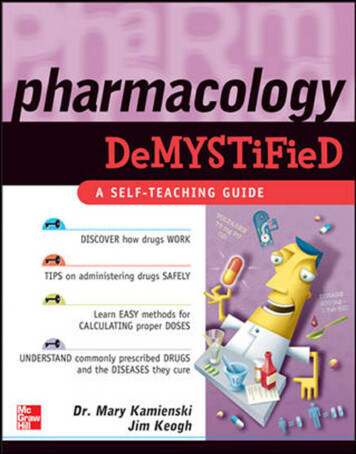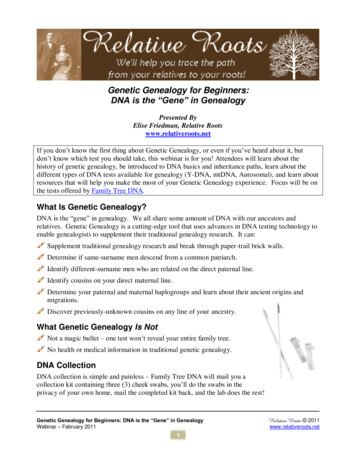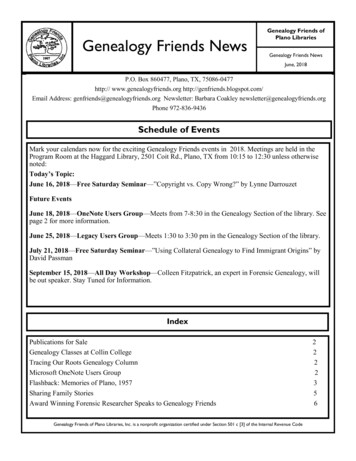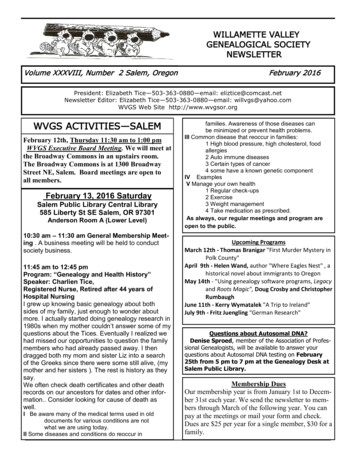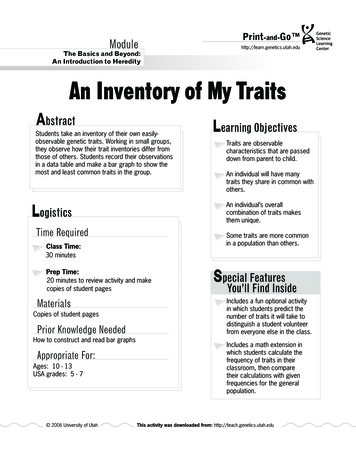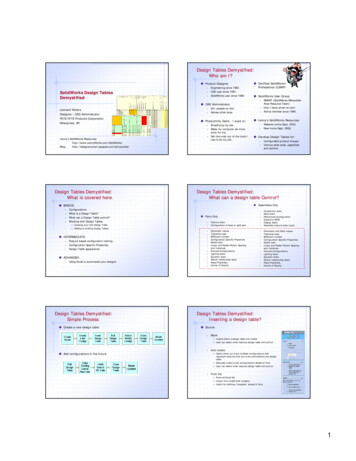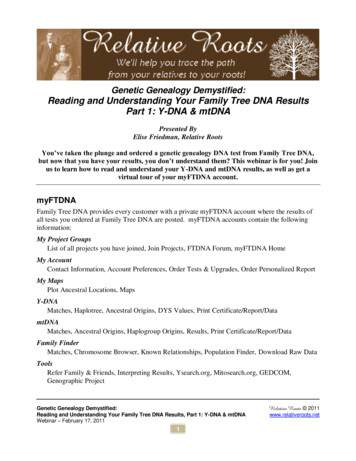
Transcription
Genetic Genealogy Demystified:Reading and Understanding Your Family Tree DNA ResultsPart 1: Y-DNA & mtDNAPresented ByElise Friedman, Relative RootsYou’ve taken the plunge and ordered a genetic genealogy DNA test from Family Tree DNA,but now that you have your results, you don’t understand them? This webinar is for you! Joinus to learn how to read and understand your Y-DNA and mtDNA results, as well as get avirtual tour of your myFTDNA account.myFTDNAFamily Tree DNA provides every customer with a private myFTDNA account where the results ofall tests you ordered at Family Tree DNA are posted. myFTDNA accounts contain the followinginformation:My Project GroupsList of all projects you have joined, Join Projects, FTDNA Forum, myFTDNA HomeMy AccountContact Information, Account Preferences, Order Tests & Upgrades, Order Personalized ReportMy MapsPlot Ancestral Locations, MapsY-DNAMatches, Haplotree, Ancestral Origins, DYS Values, Print Certificate/Report/DatamtDNAMatches, Ancestral Origins, Haplogroup Origins, Results, Print Certificate/Report/DataFamily FinderMatches, Chromosome Browser, Known Relationships, Population Finder, Download Raw DataToolsRefer Family & Friends, Interpreting Results, Ysearch.org, Mitosearch.org, GEDCOM,Genographic ProjectGenetic Genealogy Demystified:Reading and Understanding Your Family Tree DNA Results, Part 1: Y-DNA & mtDNAWebinar – February 17, 20111Relative Roots 2011www.relativeroots.net
Review of DNA BasicsOur DNA consists of:46 chromosomes (23 pair)22 pair autosomal chromosomes, or autosomes1 pair gender chromosomes (X,Y) (women have XX, men have XY)Mitochondrial DNA (mtDNA)DNA Sequences & MutationsDNA is made up of four (4) bases: Adenine (A), Cytosine (C), Guanine (G), Thymine (T)Mutations (changes) in the DNA happen over time. Mutations happen randomly, but always happenbetween a parent/child pair. Mutations are what enable us to do genealogy and ancestry studies.They differentiate us from people who we’re not closely related to, while matching us with peoplewho we are closely related to. Genetic genealogy uses two types of mutations: STR and SNP.DNA Sequence – a string of consecutive basesExample: TAGCAAAGTCCCATGCCCCAGTCAGTCGGGAShort Tandem Repeat (STR) - DNA sequence of short repeating segments.Example: GATCGATCGATCGATCGATCGATCGATCGreat for genealogy. Family Tree DNA’s Y chromosome markers are STRs.Alleles – Number of repeating segments at an STR markerThe above sequence has 7 alleles (GATC repeated 7 times).Example: DYS393 12 means you have 12 alleles (repeats) at marker DYS393.Haplotype – Sequence of allelesExample: 12 23 14 10 13 17 11 16 11 13 11 30Single Nucleotide Polymorphism (SNP) – Base change at a single location in the DNAExample: C G, or A TRare occurrences in Y-DNA and mtDNA, so great for deep ancestry studies.Great for autosomal studies when used in large quantities.Haplogroup – Broad division of the human population, defined by Y-DNA and mtDNA SNPs.Represents deep/ancient ancestry (thousands to tens of thousands of years).Separate Y chromosome and mtDNA haplogroups.Can be divided into subgroups, known as subclades.Haplogroups are hierarchical, similar to an outline.Haplogroup names start with a capital letter, then alternate numbers and lower case letters.Example: J1e. J is the main haplogroup name, J1 is a subclade of J, and J1e is a subclade of J1.Genetic Genealogy Demystified:Reading and Understanding Your Family Tree DNA Results, Part 1: Y-DNA & mtDNAWebinar – February 17, 20112Relative Roots 2011www.relativeroots.net
Reading & Understanding Y-DNA ResultsFamily Tree DNA offers four (4) levels of standard Y-DNA testing – 12, 25, 37 and 67 STR markers– as well as a wide variety of advanced STR and SNP tests.STRsFamily Tree DNA provides the STR allele values on the Y-DNA DYS Values page of yourMyFTDNA account:How to Read the ResultsDYS393 12, DYS390 23, DYS19 14, etc.Comparing ResultsY-DNA matches do not necessarily have to be exact to be significant. Since mutations happenrandomly – always between a parent/child pair – a father and son can have a mismatch on a marker.So relationship predictions are always provided in terms of probabilities.In the above example, Male 1 and Male 2 match on 11 out of 12 markers. At DYS385b, they have amismatch. This example came from two people who are known to be recently related, but an 11/12match could also exist between two people who aren’t recently related.An 11/12 match has a 90% chance of being related within 39 (from 1 to 39) generations.A 36/37 match has a 90% chance of be related within 8 (from 1 to 8) generations.37 markers and higher is best for identifying matches within genealogical timeframe.Y-DNA Haplogroups/SNPsY-DNA SNPs define Haplogroups. SNP names typically start with a capital letter, followed bydigits. Each SNP name corresponds to a hierarchical Haplogroup name. For example, haplogroupE1b1b1 is defined by a SNP called M35. The SNP or change at M35 is from a G to C. Viewing a Ychromosome tree such as the one on the Haplotree page of your myFTDNA account is the best wayto see the correlation between SNP and Haplogroup names.Family Tree DNA provides a free backbone (top-level) Haplogroup prediction for every customerwho orders a Y-DNA test. Predictions are done using Family Tree DNA’s robust database ofcustomers who have already been SNP-tested. Predictions can be confirmed by ordering an optionalSNP test. An optional deep-clade SNP test can also be ordered to refine the Haplogroup assignmentto the deep subclade (subgroup) level.Genetic Genealogy Demystified:Reading and Understanding Your Family Tree DNA Results, Part 1: Y-DNA & mtDNAWebinar – February 17, 20113Relative Roots 2011www.relativeroots.net
Reading and Understanding mtDNA ResultsmtDNA contains 16,569 bases.Family Tree DNA offers three (3) levels of mtDNA testing: mtDNA Basic, mtDNA Plus and FullMitochondrial Sequence (FMS).mtDNA BasicTests a section of the mtDNA known as Hypervariable Region 1 (HVR1), which has 569 bases.mtDNA PlusTests HVR1 plus a second section known as HVR2, which has 574 bases.Full Mitochondrial Sequence (FMS) [previously known as FGS, Full Genomic Sequence]Tests the entire Mitochondria – 16,569 bases.Cambridge Reference Sequence (CRS)First full mtDNA sequence ever completed. Family Tree DNA reports results as differencesfrom the CRS.The following chart shows results for a sample Full Mitochondrial Sequence test: HVR1, HVR2 andthe rest of the mtDNA, known as the Coding Region (CR). Each value shown is a difference fromthe CRS.How to Read the Results16224C At location 16,224 on the mtDNA, this sample has a C instead of the reference value.The chart to the right shows the reference (CRS) value atposition 16224 as T, while this sample has a C.Comparing ResultsIn most cases, mtDNA matches should be exact. Thedifferences from the CRS are compared:HVR1 Differences from CRSPerson 116224C, 16234T, 16311C, 16519CPerson 216224C, 16234T, 16311C, 16519CGenetic Genealogy Demystified:Reading and Understanding Your Family Tree DNA Results, Part 1: Y-DNA & mtDNAWebinar – February 17, 20114Relative Roots 2011www.relativeroots.net
Person1 and Person 2 have an exact match at HVR1, so they should also compare their results atHVR2 and the Coding Region.Exact HVR1 match: 50% chance of a common ancestor within 52 generations.Exact HVR1 HVR2 match: 50% chance of a common ancestor within 28 generations.Full Mitochondrial Sequence match: 50% chance of a common ancestor within 5 generations.mtDNA HaplogroupsThe backbone (top-level) mtDNA Haplogroup is determined by an included test of approximately 20locations that define the major haplogroups. Subclades are determined by the Full MitochondrialSequence.Making the Most of Your Genetic Genealogy ExperienceReceiving, reading and understanding your results shouldn’t be the end of your genetic genealogyexperience. Here are some ways you can make the most of this experience:Inform. Your myFTDNA account has fields to enter your Most Distant Known Ancestor’s(MDKA) name and location, as well as all the surnames in your ancestry. You can alsoupload a GEDCOM of your family tree. Entering all this information will enable yourmatches to learn something about your genealogy before they even contact you.Communicate. Don’t be afraid to email your matches, and definitely respond to emails thatyou receive from your matches! All customers can choose whether to sign the green releaseform that Family Tree DNA provided with your swab kit, which gives FTDNA permission toprovide their name and email address to matches. So everyone who you see on your matchespage had signed this form and given permission.Participate. Family Tree DNA has over 6,000 different projects which focus on surname,geography, heritage and haplogroups. Projects are all run by volunteer administrators andare free to join. Joining projects is the best way to stay informed about news related to thetopic of the project, and you have the added benefit of getting support and assistance fromyour project administrator.Be Proactive. No project for your surname yet? Start one and recruit other people with yoursurname to get tested. You don’t have to be an expert on genetic genealogy to start a project.Learn. Keep learning about genetic genealogy by attending Relative Roots Webinars,visiting the International Society of Genetic Genealogy website, and joining discussionforums and email lists that discuss genetic genealogy. Project administrators are also invitedonce a year to attend a conference hosted by Family Tree DNA in Houston.Genetic Genealogy Demystified:Reading and Understanding Your Family Tree DNA Results, Part 1: Y-DNA & mtDNAWebinar – February 17, 20115Relative Roots 2011www.relativeroots.net
WebsitesRelative Rootso http://www.relativeroots.netFamily Tree DNAo http://www.familytreedna.com/International Society of Genetic Genealogy (ISOGG) – it’s free to join!o http://www.isogg.orgGenetic genealogy mailing lists and discussion forums:o http://www.yahoogroups.com/group/ISOGGo http://www.yahoogroups.com/group/DNA-Newbieo http://forums.familytreedna.como http://www.dna-forums.orgo http://lyris.jewishgen.org/ListManager (JewishGen)o /GENEALOGY-DNA.htmlPublic Searchable DatabasesYsearcho http://www.ysearch.orgmitoSearcho http://www.mitosearch.orgSMGFo http://www.smgf.orgYHRDo http://www.yhrd.orgThank you for attending a Relative Roots webinar!Please visit our website often to learn about additional webinars and/or join the Relative RootsWebinars Announcements email list at http://www.relativeroots.net/webinars/Follow Relative Roots on Facebook and com/RelativeRootsGenetic Genealogy Demystified:Reading and Understanding Your Family Tree DNA Results, Part 1: Y-DNA & mtDNAWebinar – February 17, 20116Relative Roots 2011www.relativeroots.net
Genetic Genealogy Demystified: Relative Roots 2011 Reading and Understanding Your Family Tree DNA Results, Part 1: Y-DNA & mtDNA www.relativeroots.net Webinar .
